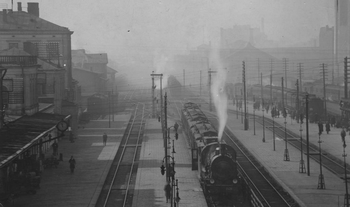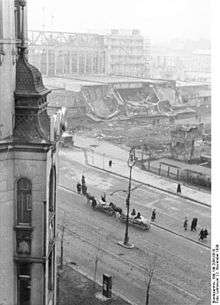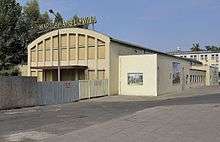Warszawa Główna railway station
Coordinates: 52°13′35″N 20°59′14″E / 52.2263°N 20.9871°E

Warsaw Main Railway Station (Polish: Warszawa Główna) was the name of two different railway stations in Warsaw, Poland, both now defunct.
History
The first idea of construction of a main Warsaw station, which would have been the nexus of all rail lines in the city, appeared in 1879. In practical terms, with one standard gauge line and a few broad gauge railway lines terminating in Warsaw in the 19th century, creating a single 'main' station would have been far from a trivial proposition. However, when Poland regained independence and the standard gauge was universally adopted, this project was revived. In 1921, when works on the modernisation of the Warsaw railway hub started, it became clear that it was necessary to demolish the obsolete Vienna Station. This having been done, passenger traffic was taken over by a temporary station on Chmielna street, which opened in 1921.
Construction
It was decided that after the demolition of the Vienna Station, a new station would be constructed. The works began in 1932, and the monumental complex was designed by architects Czesław Przybylski and Andrzej Pszenicki, while Wacław Żenczykowski was the structural engineer. The station was supposed to become the most important railway station of the Second Polish Republic and one of the most modern in contemporary Europe. The complex was to be furnished with most modern appliances, including electric heating.
The station building was located along the Warsaw’s main street, Aleje Jerozolimskie, between Marszałkowska and Emilii Plater streets (52°14′35″N 20°59′59″E / 52.2430°N 20.9997°E), and the platforms were in a tunnel on the cross-city line (Polish: linia średnicowa).
The station was designed in the Modernist Style, with then popular Art deco elements. The architects intended for the station to be multi-functional; therefore plenty of space had been designed for various stores, entertainment, and restaurants. As construction continued in 1938, first passengers were able to use the partly completed Warsaw Main Rail Station. However, the building was never completed because of the outbreak of the Second World War.
World War II

A few weeks before the war, on June 6, 1939, the still unfinished station was partly destroyed in a fire which had been started by a team of reckless welding contractors. Initially many people believed that it had been an act of sabotage by German or Soviet agents. During the course of fighting the fire, led personally by the minister of the interior Felicjan Sławoj-Składkowski, one fireman died and three were wounded.
In September 1939, the station was damaged during the Siege of Warsaw (1939). Later, German authorities made some improvements, e.g. construction of a new roof. The station, though still unfinished and partly destroyed, remained operational. This lasted until the Warsaw Uprising when, as a result of battle, the damage to the station got significantly bigger. In January 1945 the Germans, soon before retreating from Warsaw, blew the remains up.[1]
Post-WWII

After the war, a new Warszawa Główna station (actually a few adopted tracks of a former goods yard, plus a temporary wooden building on Towarowa Street) took the mainline services over. Since 1975 Warszawa Centralna railway station has been Warsaw’s principal station, but some scheduled and special trains continued to use the Warsaw Main station until 1997. The wooden building is still standing, though in a very poor condition, and houses a part of the Railway Museum.
References
Bibliography
- Jerzy S. Majewski, Warszawa nieodbudowana. Lata trzydzieste, Warszawa, 2005, ISBN 83-85584-91-9.
External links
- Plans of the station and phases of construction
- Warsaw firefighters trying to extinguish the fire,June 6, 1939
- Color photograph of the station, taken by an unknown German soldier in the early 1940s